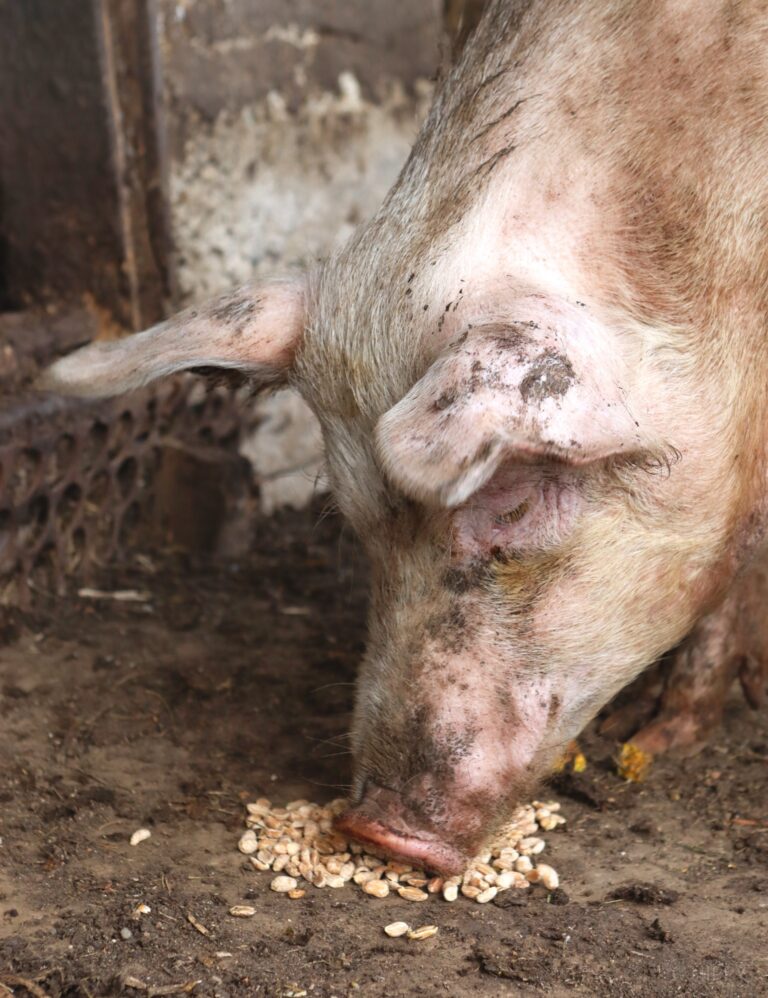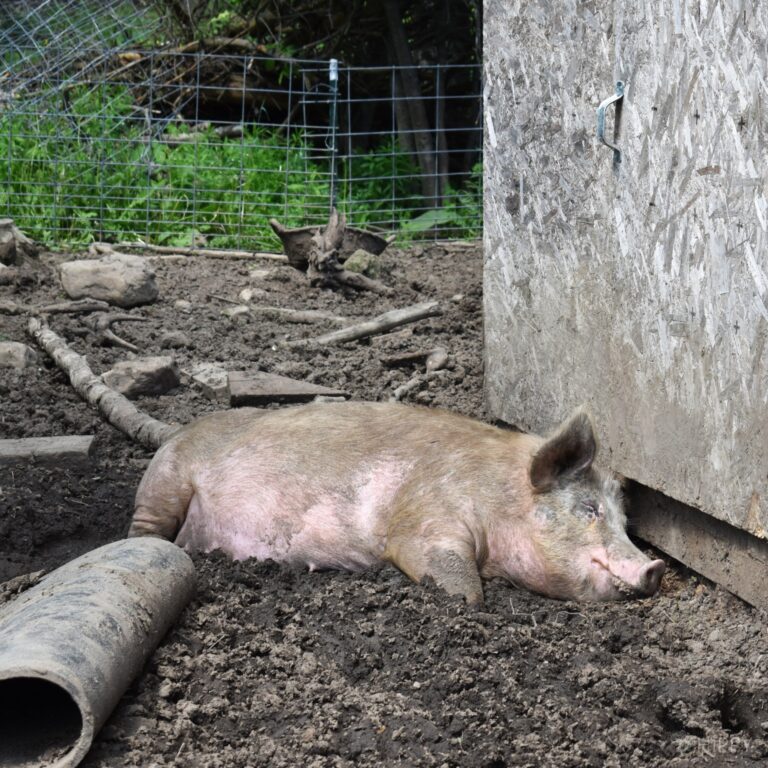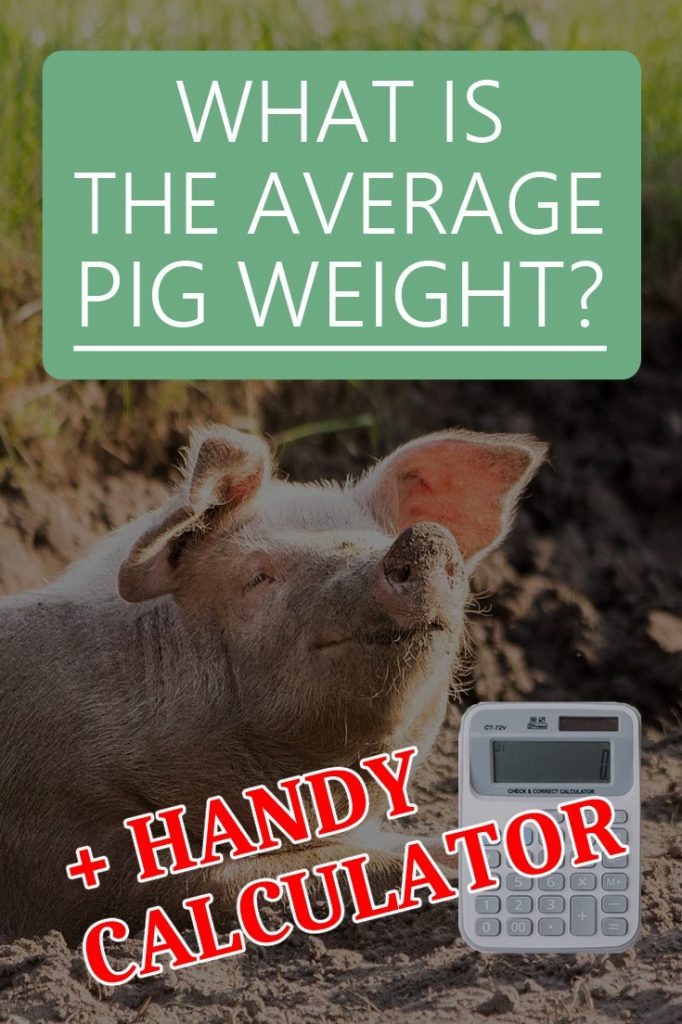If you’re thinking about raising pigs on your farm or homestead, you might be wondering what kinds of goals you should be aiming for.
Namely, you might want to know what the average pig weight is so you know you are feeding it and caring for it properly before slaughter.

Luckily, in the last few decades, better breeding and higher feed efficiency have improved the average pig weight from the market. Just how much does the average pig weigh nowadays?
The average mature pig weight comes in around 275 pounds (125 kilograms). This can vary depending on the breed and the conditions in which you are raising your pigs.
That’s the average weight for market pigs – mature breeding pigs can weigh between 300 and 700 lbs…
That being said, there are many factors behind optimal weight, and a heavier pig isn’t always a better pig. You’ll need to account for all factors.
Table of Contents
Helping My Pig Gain Weight
There are several tips you can follow to help your pig get to a healthy slaughter weight in a short – but reasonable – amount of time…
Provide a Health Diet with the Right Vitamins and Minerals
First, provide your pig a mixed diet that includes foods like:
- Grain (most grain mixtures contain things like corn, barley, wheat, and soybean meal for a balanced blend)
- Alfalfa
- Mineral mixtures
- Food scraps
- Fresh pasture
Make Sure Your Pigs Have Plenty of Water in Their Housing Facilities
Provide plenty of fresh, clean water, too. A pig that’s dehydrated will be a pig that doesn’t eat as much and will put on weight slowly.
The water needs to be super clean to prevent parasites, which can also cause your pig to gain weight more slowly.
Give Them Some Space
While we’re on the subject of parasites, get in the habit of providing your pigs as much room as possible. Lots of people raise their pigs in small pens or even on concrete pads.
You can do that, but they’re not going to grow as quickly or as efficiently. You’re also going to have to rely on dewormers to keep parasites at bay.
Instead, consider raising your pigs on pasture. There’s a common myth out there that pigs allowed to roam will produce meat that is tough and gamey.
Our pigs are raised on more than ⅔ of an acre, and we have never found that to be the case. On the contrary, you will get meat that is lean and flavorful – meaning less waste when it comes to discarding fat at butchering time.
Deworm Your Pigs As Needed
Despite having our pigs in the pasture, we deworm them once a month. Chemicals aren’t necessary to deworm your pigs – something as simple as garlic and apple cider vinegar should do the trick (the garlic can also help with the flies, too).
Provide Vitamin and Mineral Supplements
One way to help your pigs reach their potential is by providing vitamin and mineral supplements.
These supplements can help to correct any imbalances in the diet and ensure that your pigs are getting all the nutrients they need. In addition, vitamin and mineral supplements can help to boost growth rates and improve feed efficiency
These supplements are sometimes added to the feed already, so be sure to check before you add anything else.
One supplement we’ve found to be particularly effective for our pigs is kelp. It helps prevent disease and keeps the pigs gaining weight at a healthy rate.
Set Up Automatic Feeders and Waterers to Ensure Weight Gain
No matter what you feed, consider setting up automatic feeders and waterers.
Pigs can drink out of nipple water and you can easily affix these to a plastic barrel or drum to provide a steady supply of water that you only have to fill once or twice a week.
Again, you don’t want your pigs running out of water because they won’t eat and they won’t gain weight.
Don’t think that just by being diligent you can provide them with all the water they need to put on weight, either. Pigs are messy, and they love nothing more than tipping their water dishes over and splashing around in the resulting mud.
Set up some kind of automatic waterer that they can’t flip, and you’ll thank yourself later on.
The same goes for the feeder. You’re going to waste a lot of food by feeding your pigs in a basic trough for a feeding pan.
Build an automatic feeder that has a cover the pigs can lift with their snouts. This will keep the food protected from the rain and, if the lid is heavy enough, rodents.
Your pigs can help themselves whenever they want and your feeding chores will be reduced to about once per week.
Provide Scraps to Market Pigs
Feel free to feed your pigs all the scraps you want, too. If you can get your hands on free bread, brewer’s grain, vegetables, milk, or eggs, that’s all the better.
Just try to avoid feeding one kind of food in excess, as it can make your pigs overfat and leave an odd flavor in the meat.

Two other factors – consider the time of year you raise your pigs, and also who you are raising them with. You can certainly raise one pig by itself, but you may find that your pigs gain weight better when raised with other pigs.
Competition increases food consumption – that’s anecdotal, but it’s a fact I’ve always found to be true.
Time of year is important because you want your pigs to be spending their energy on gaining weight, not on keeping warm. If you must raise pigs during the winter, make sure you have good shelter for them to go into to get out of the precipitation and wind.
How to Calculate Pig Weight
For every 200 pound (90 kgs) pig (live weight) you will get about 55 lbs (25 kgs) of hams and pork shoulder (or chops) 40 lbs (18 kgs) of bacon and loin, and all the trimmings like sausage, lard, etc. For a family of four, one pig is really all you need.
When calculating pig weight, you’ll have two weights to measure: hanging weight and live weight.
Hanging weight is how much your pig weighs after all of the trimmings – like the head, hide, blood, hooves, lungs, viscera, and heart – have been removed. It’s usually about 40% of the live weight.
You won’t know this until you get your pig on the scales after slaughter, but you can take a rough estimate.
Live weight can be determined with an easy calculation. Don’t worry, you don’t have to get your pig on a scale, either! All you have to do is use some fabric measuring tape.
Put the tape on the pig just behind its front legs. Measure its girth in inches. Then, measure its length, taking the measurement from the base of its ears to its tail. This is also done in inches.
Square the girth, then multiply it by the length and divide it by 400. This will give you the approximate weight of your pig in pounds:
GIRTH X GIRTH X LENGTH / 400 = PIG WEIGHT
One note – this is easier to do on older pigs than on younger ones. They tend to squirm a bit less, and will be much more accommodating when it comes to having a measuring tape wrapped around them!
Pig Weight Calculator
Even though the formula above is pretty straightforward, let’s save you some time. Enter the girth and length below to quickly estimate your hog’s weight:
Girth: |
||
Length: |
||
What Pig Breeds Get the Largest?
Most pig breeds produce animals that can be raised to suitable market weight. However, when buying a pig of any breed, you’ll want to check the genetic stock.
Make sure your pig is from clean, disease-free lineage, and try not to buy a runt. While runts sometimes prove you wrong, they often just don’t grow as large as their siblings.
A good trait to keep an eye out for is a pig that is long. One that is squat and short will produce more lard.
Breed is less important, as all breeds have been developed to produce meat, but if you’re looking for a good ham and bacon pig (typically considered the best meat pigs) you will want to choose from:
- Yorkshire
- Duroc
- Berkshire
- Landrace
- Chester White
- Hampshire
- Tamworth
The following are other common pig breeds you can raise, but since they were bred to be lard producing pigs, they might not be as lean as you’d like:
- Large Black
- Gloucestershire Old Spots
- Mulefoot
- Meishan
- Potbelly
Average Pig Weights At Various Stages
While no two pigs will be exactly the same, here are a few estimates pig farmers can use to know if their pig’s dimensions are in line with the average daily gain and overall weight of pigs in the same category.
Average Piglet Weight
The average weight of a piglet at birth is around 2.5 pounds. Piglets typically double their birth weight within the first week of life, and by six weeks old (one to two months of age) they will usually weigh between 20 and 30 pounds.
After that, their growth rate will start to slow down, but they will continue to put on weight until they reach full maturity at around six months old.
On average, adult pigs weigh between 250 and 300 pounds, although there are some breeds that can grow to be much larger.
Consequently, piglets are born quite small but have the potential to grow into very large animals.
Weight of Nursery Stage Pigs
The average weight of a nursery stage pig is between 20 and 50 pounds. The weight of a nursery pig depends on several factors, including the breed, sex, and age of the pig. For example, larger breeds of pigs will typically weigh more than smaller breeds.
Optimum Market Weight of Pigs
There is debate in the swine industry about what is the optimum market weight of pigs. The majority of the pork you find in the grocery store come from pigs that weigh between 250 and 280 pounds.
But, there has been a trend in recent years towards producing “mini-pigs” that weigh around 200 pounds.
The main advantage of the mini-pigs is that they require less feed to reach market weight, which makes them more efficient and environmentally friendly. Another advantage is that they tend to have less fat than their larger counterparts, which is healthier for both pigs and consumers.
However, some experts argue that mini-pigs are too small to produce tasty pork chops and other popular cuts of meat. And, because they have less fat, they also tend to have less flavor.
It really does depend, but you should shoot for a pig that’s in the 200 to 250 lb range when you’re raising pigs to the desired slaughter weight.
Average Show Pig Weight
The average show pig weight can vary depending on the breed of pig. Some breeds of pigs grow to be very large, while others are smaller in size. On average, a show pig (sows, boars, gilts, and barrows) typically weighs between 200 and 300 pounds.
The bigger the pig, the more impressive it usually is to the judges. Consequently, many people try to breed pigs that are on the larger side. However, it is important to remember that pigs come in all shapes and sizes, and there is no one perfect weight for a show pig
Average Weight of an Adult Pig
On average, an adult pig weighs between 250 and 600 pounds. Sows, or female pigs, tend to be slightly smaller than boars, or male pigs.
However, both sows and boars can reach weights over 1,000 pounds if they are well-fed and cared for.
Sows
Sows, or female pigs, generally weigh between 500 and 700 pounds.
Boars
Boars, or male pigs, weigh between 600 and 800 pounds. Some pigs may grow to be even larger than this, but they are not considered to be the norm.
When Heavier Isn’t Always Better
Remember – bigger isn’t always better, and that applies to pigs, too. While you can certainly raise a pig until it is several hundred pounds (our breeding sow, Boo, weighs close to 700 pounds – 317 kgs) there’s not much of an advantage to doing this.
Once pigs get to about 225 pounds (102 kgs), their ratio of weight gained to food consumed drops significantly. This means that you’ll be spending more money to feed a pig without a lot of return.
If you somehow have access to free food (or have your pigs on pasture) that might not be a bad thing.
However, if you’re feeding your pigs grain, your goal here should be to optimize your feed conversion rate so you’re not flushing money down the toilet.
Once pigs start to get too big, the meat quality also declines. More weight doesn’t necessarily mean more ham, bacon, and pork chops – it often just means more lard.
If you’re not doing anything with the pig fat, that means you will be throwing out most of that extra weight when it comes to butchering a pig, anyway.
Follow the right steps, though, and you will raise a pig that is not only lean and large, but produces incredibly delicious meat!
FAQ
A healthy weight for a pig depends on a number of factors, including age, breed, and activity level. For example, an adult pot-bellied pig typically weighs between 150 and 250 pounds, while a juvenile pig of the same breed may only weigh 50 pounds. Mature farm pigs for breeding may be as heavy as 700 lbs.
Pigs can be butchered for meat at a variety of weights, but most commercial operations target pigs that weigh between 250 and 300 pounds.
Pigs that are too small may not have enough meat to make the effort worthwhile, while pigs that are too large can be more difficult to handle and process.
First, check to see if there is a fold of skin behind the pig’s shoulders. This fold should be barely visible. If it is noticeably large, then the pig is likely overweight. Another sign to look for is an indentation above the pig’s tail. This area should be smoothly rounded. If it is sunken in, then the pig may be carrying too much weight.
Finally, take a look at the pig’s hind legs. If they seem bowed or ill-fitting, this could be another sign of excess weight.
A typical 6-month-old pig should weigh between 120 and 140 pounds. However, there can be significant variation in weight depending on the breed of pig.
The first step is to secure the pig in a chute or pen so that it can’t move around. Then, use a soft measuring tape to wrap around the girth of the pig’s body, just behind the front legs.
Make sure that the tape is level and not too tight before reading the measurement. Once you have the girth measurement, you can use a weight chart to estimate the pig’s weight.


Rebekah is a full-time homesteader. On her 22 acres, she raises chickens, sheep, and bees, not to mention she grows a wide variety of veggies. She has a huge greenhouse and does lots of DIY projects with her husband in her ever-growing homesteading endeavor. Learn more about Rebekah here.

50 years ago I lived in TX where my uncle had a hog ranch and farm.
His sows were probably 500 pounds, his boar…all I know was he was HUGE.
Market weight was 200 pounds on the hoof average. 195-205 paid top dollar. Over or under the price per pound was SEVERELY reduced.
The lots do not want to feed or pay for fat (and I have seen a LOT of really fatty meat lately).
Chickens…back then were 3.5 pound average without neck but including liver and gizzard. Today chickens are 5 pound average normally. I never purchase chickens that large and have to look for dry chicken at 3.5. hard to find with gizzard and livers!